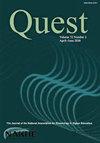加强体育教师教育中的集体行动:三个途径
IF 1.7
3区 教育学
Q2 EDUCATION & EDUCATIONAL RESEARCH
引用次数: 1
摘要
体育教育的改进工作往往是通过单一的、单向度的镜头来针对复杂的问题。鉴于体育教育系统及其组成部分之间相互关联和复杂的关系,这种策略的效果较差。系统规划动力学在文献中代表性不足,但考虑到使用该框架的相互关联的体育系统组成部分可能有助于塑造更理想的未来。在系统思维的框架下,集体行动方法侧重于可以导致创新和改进的各种系统组件。这一分析重新审视了“体育教育系统”作为一个分析的、以行动为导向的核心的想法。这篇理论论文的目的是提出并证明集体行动是改善体育教师教育(PETE)的一个重要方面,并推荐一种跨体育教师教育项目和内部集体行动策略的三途径方法。如果体育教育要作为一个统一的实体发挥作用,PETE项目就需要树立集体行动的榜样,让学生为这项重要的工作做好准备。本文章由计算机程序翻译,如有差异,请以英文原文为准。
Enhancing Collective Action in Physical Education Teacher Education: A Three-Pathways Approach
ABSTRACT Improvement efforts in physical education have often targeted complex issues through a singular, unidimensional lens. This strategy is less effective given the interrelated and complex relationship among the physical education systems and its components. Systems planning dynamics are underrepresented in the literature, but considerations for the interrelated physical education system components using this framework may help in shaping a more desirable future. Framed by systems thinking, a collective action approach focuses on various systems components that can lead to innovation and improvement. This analysis revisits the idea of a “physical education system” as an analytical, action-oriented centerpiece. The purpose of this theoretical paper is to present and justify collective action as an essential aspect of improving physical education teacher education (PETE) and to recommend a three-pathways approach for collective action strategies across and within PETE programs. If physical education is to function as a unified entity, PETE programs will need to model collective action and prepare students for this important work.
求助全文
通过发布文献求助,成功后即可免费获取论文全文。
去求助
来源期刊

Quest
社会科学-运动科学
CiteScore
4.50
自引率
14.30%
发文量
16
期刊介绍:
Quest is the official journal of the National Association for Kinesiology in Higher Education (NAKHE). It is the leading journal for interdisciplinary scholarship for professionals in kinesiology in higher education. Quest provides a public forum for scholarship, creative thought, and research relevant to a broad range of interests held by faculty and leaders in higher education today.
Quest publishes: 1) manuscripts that address issues and concerns relevant and meaningful to the field of kinesiology; 2) original research reports that address empirical questions that are contextualized within higher education and hold significance to a broad range of faculty and administrators in kinesiology; and 3) reviews of literature and/or research of interest to one or more sub-disciplines in kinesiology. Quest does not publish papers focused on sport (e.g., amateur, collegiate, professional) that are contextualized outside of kinesiology in higher education.
 求助内容:
求助内容: 应助结果提醒方式:
应助结果提醒方式:


